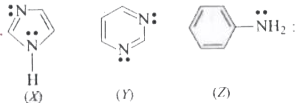CH3NH2+CHCl3+KOH→ nitrogen containing compound +KCl+H2O. Nitrogen containing compound is
CH3−C≡N
CH3−NH−CH3
CH3−θN≡⊕C
CH3⊕N≡θC
The correct Answer is:d
To solve the given question, we need to analyze the reaction between methylamine (CH₃NH₂), chloroform (CHCl₃), and potassium hydroxide (KOH). This reaction is a classic example of the carbylamine reaction, which is used to identify primary amines.
1. Identify the Reactants:
- The reactants are methylamine (CH₃NH₂), chloroform (CHCl₃), and potassium hydroxide (KOH).
- Methylamine is a primary amine.
2. Understand the Reaction Type:
- The reaction is known as the carbylamine reaction, which occurs specifically with primary amines.
- In this reaction, the primary amine reacts with chloroform in the presence of a strong base (KOH) to form an isocyanide.
3. Write the Reaction:
- The primary amine (CH₃NH₂) reacts with chloroform (CHCl₃) and KOH to produce methyl isocyanide (CH₃N≡C), potassium chloride (KCl), and water (H₂O).
- The overall reaction can be represented as:
CH₃NH₂ + CHCl₃ + KOH \rightarrow CH₃N≡C + KCl + H₂O
4. Identify the Nitrogen-Containing Compound:
- The nitrogen-containing compound formed in this reaction is methyl isocyanide (CH₃N≡C).
- This compound is characterized by the presence of a carbon-nitrogen triple bond.
5. Final Products:
- In addition to methyl isocyanide, the other products of the reaction are potassium chloride (KCl) and water (H₂O).
Conclusion:
The nitrogen-containing compound formed in the reaction is methyl isocyanide (CH₃N≡C).
- The reactants are methylamine (CH₃NH₂), chloroform (CHCl₃), and potassium hydroxide (KOH).
- Methylamine is a primary amine.
- The reaction is known as the carbylamine reaction, which occurs specifically with primary amines.
- In this reaction, the primary amine reacts with chloroform in the presence of a strong base (KOH) to form an isocyanide.
- The primary amine (CH₃NH₂) reacts with chloroform (CHCl₃) and KOH to produce methyl isocyanide (CH₃N≡C), potassium chloride (KCl), and water (H₂O).
- The overall reaction can be represented as:
CH₃NH₂ + CHCl₃ + KOH \rightarrow CH₃N≡C + KCl + H₂O
- The nitrogen-containing compound formed in this reaction is methyl isocyanide (CH₃N≡C).
- This compound is characterized by the presence of a carbon-nitrogen triple bond.
- In addition to methyl isocyanide, the other products of the reaction are potassium chloride (KCl) and water (H₂O).
The nitrogen-containing compound formed in the reaction is methyl isocyanide (CH₃N≡C).
Topper's Solved these Questions
- AROMATIC COMPOUNDS AND ALKYL AND ARYL HALIDES BOOK - CENGAGE CHEMISTRY ENGLISHCHAPTER - AROMATIC COMPOUNDS AND ALKYL AND ARYL HALIDES EXERCISE - Archives Single Correct Answer Type
3 Videos
- AROMATIC COMPOUNDS AND ALKYL AND ARYL HALIDES BOOK - CENGAGE CHEMISTRY ENGLISHCHAPTER - AROMATIC COMPOUNDS AND ALKYL AND ARYL HALIDES EXERCISE - Archives Mutiple Correct
5 Videos
- AROMATIC COMPOUNDS AND ALKYL AND ARYL HALIDES BOOK - CENGAGE CHEMISTRY ENGLISHCHAPTER - AROMATIC COMPOUNDS AND ALKYL AND ARYL HALIDES EXERCISE - Exercises Assertion-Resoning
11 Videos
- APPENDIX INORGANIC VOLUME 2BOOK - CENGAGE CHEMISTRY ENGLISHCHAPTER - APPENDIX INORGANIC VOLUME 2EXERCISE - Short Answer Type
179 Videos
- BIOMOLECULESBOOK - CENGAGE CHEMISTRY ENGLISHCHAPTER - BIOMOLECULESEXERCISE - Exercises Archives (Analytical And Descriptive)
8 Videos
Similar Questions
Knowledge Check
Arrange the following nitrogen containing compounds in decreasing order of basicity
 AP>Q>R>SBQ>P>R>SCQ>P>S>RDS>P>Q>R
AP>Q>R>SBQ>P>R>SCQ>P>S>RDS>P>Q>RArrange the following nitrogen containing compounds in decreasing order of basicity
 AS>R>Q>PBP>Q>S>RCP>QR>SDR>Q>P>S
AS>R>Q>PBP>Q>S>RCP>QR>SDR>Q>P>SArrange the following nitrogen containing compounds in decreasing order of basicity
 AR>S>P>QBQ>P>R>SCS>R>P>QDR>S>Q>P
AR>S>P>QBQ>P>R>SCS>R>P>QDR>S>Q>P
The nitrogen containing compound produced in the reaction of NH3 with sodium hypochlorite is
View SolutionNitrogen containing organic compound when fused with sodium metal forms :
View SolutionThe nitrogen containing compound produced in the reaction of NH3 with excess of Cl2 is
View SolutionArrange the following nitrogen containing compounds in decreasing order of basicity

View SolutionArrange the following nitrogen containing compounds in decreasing order of basicity

View Solution
